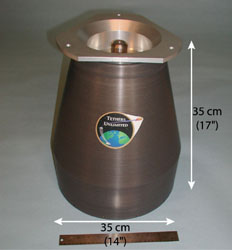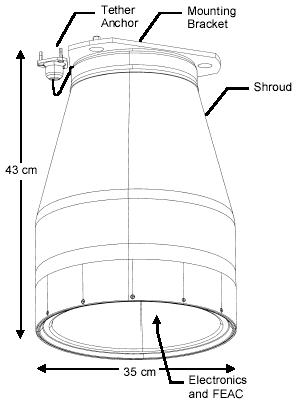Science Fiction
Dictionary
A B C D E F G H I J K L M N O P Q R S T U V W X Y Z
Terminator Tether - EDT Solution To Space Debris Update

You wouldn't think that humanity has been this busy in space - but there are over nine thousand satellites and other large objects in orbit around the Earth, along with many smaller objects. These objects include spent vehicle upper stages, separation bolts, lens caps, momentum flywheels, nuclear reactor cores, auxiliary motors and launch vehicle fairings. Material degradation due to atomic oxygen, solar heating and solar radiation produces particulate matter. Solid rocket motors used to boost satellite orbits leave motor casings, nozzle slag, solid-fuel fragments and exhaust cone bits. More than 124 satellite breakups have been verified; many more are believed to have occurred; these are generally caused by explosions and collisions. Satellites or other objects in orbit higher than 700 kilometers will stay there for hundreds of years; LEO satellites have an average working life of just five years.
Studies have shown that low Earth orbit is not a limitless resource and should be managed more carefully. Some sort of debris-mitigation measures are needed to solve the problem of old, unusable satellites and space junk.
Arthur C. Clarke had exactly this problem when he was trying to build his fictional space elevator in his wonderful 1978 novel The Fountains of Paradise; he initiated Operation Cleanup:
Fortunately, the old orbital forts were superbly equipped for this task...
It has been suggested that every satellite deployed should carry extra propellant so the satellite can boost itself up to a higher "graveyard" orbit. Unfortunately, not only must the extra kilograms of propellant be boosted up from Earth, the rocket and guidance systems must be usable for many years after launch. Also, graveyard orbits merely leave satellites up higher, where micrometeorite damage slowly causes these objects to break apart; smaller fragments will filter back down, leaving this problem for our children to solve. These smaller fragments are almost impossible to clean up.
Extra propellant could also bring the satellite down; of course, this also requires that the rocket and guidance systems work at the end of the satellite's life. If either system fails to work, the satellite stays right where it is.
It would be more practical (as well as more responsible) to solve this problem at the start.
For two hundred years, satellites of all shapes and sizes, from loose nuts and bolts to entire space villages, had been accumulating in Earth orbit. All that came below the extreme elevation of the Tower, at any time, now had to be accounted for, since they created a possible hazard...
(Read more about Operation Cleanup)

(From Terminator Tether)
The Terminator Tether (TM) from TUI may be able solve this problem. Currently under development, the Terminator Tether will provide a low-cost, lightweight and reliable method of removing objects from LEO. It consists of a lightweight electrodynamic tether 5 kilometers in length wound onto a spool.

(From Terminator Tether)
Here's how it works:
The Terminator Tether is bolted onto the satellite during construction. Once launched and operational, the device is dormant, waking up periodically to check the status of the satellite and to listen for activation commands. When the command to deorbit the spacecraft is given, the 5 kilometer cable is deployed. The cable interacts with ionospheric plasma and the Earth's magnetic field; this produces a current along the tether which causes a net drag on the spacecraft, lowering its orbit until it burns up in the Earth's atmosphere. (To find out about the forces that electrodynamic tethers bring to bear on spacecraft, read Electrodynamic Tethers - Bring Down Debris or Boost Spacecraft and Non-conductive Tethers - Artificial Gravity in Orbit.)
Here are some comparative figures on deorbit times for satellites:
| Constellation | Altitude |
Inclination (Degrees) |
Deorbit |
Deorbit
Time (with Terminator Tether) |
| Orbcomm1 | 775 km |
45 |
100 years |
11 days |
| LEO One USA | 950 km |
50 |
100 years |
18 days |
| GlobalStar | 1390 km |
52 |
9,000 years |
37 days |
TUI has a promising histoy of development and funding. Started by Dr. Robert P. Hoyt and Dr. Robert L. Forward in 1994, TUI has won almost $1.5 million in grants from NASA in the past year; TUI also won a $230,000 DARPA seedling grant for space tether technologies in June of this year. This past September, they conducted successful zero-g tests in microgravity. Thanks to Tim Morrison for indirectly suggesting this story.
See also these stories on tethers and their uses in space:
- Electrodynamic Tethers: Clean Up Debris - Power or Boost Spacecraft
An electrodynamic tether (EDT) is a simple idea, but one with an amazing number of uses. - NanoTerminator Prevents Annoying Space Debris Build-Up
The nanoTerminator, recently released by TUI (Tethers Unlimited International), could help to prevent a rapidly growing problem in space - human-made debris from rockets and satellites. - Non-Conductive Tethers - Free Artificial Gravity In Orbit
Connecting two satellites in different orbits will cause them to act as one system.
Scroll down for more stories in the same category. (Story submitted 12/14/2004)
Follow this kind of news @Technovelgy.| Email | RSS | Blog It | Stumble | del.icio.us | Digg | Reddit |
Would
you like to contribute a story tip?
It's easy:
Get the URL of the story, and the related sf author, and add
it here.
Comment/Join discussion ( 10 )
Related News Stories - (" Space Tech ")
Will Space Stations Have Large Interior Spaces Again?
'They filed clumsily into the battleroom, like children in a swimming pool for the first time, clinging to the handholds along the side.' - Orson Scott Card, 1985.
Reflect Orbital Offers 'Sunlight on Demand' And Light Pollution
'I don't have to tell you about the seven two-mile-diameter orbital mirrors...'
Chrysalis Generation Ship to Alpha Centauri
'This was their world, their planet —
this swift-traveling, yet seemingly moveless vessel.' - Nat Schachner, 1934
The First Space Warship For Space Force
'Each of the electrical ships carried about twenty men...' - Garrett P. Serviss, 1898.
Technovelgy (that's tech-novel-gee!) is devoted to the creative science inventions and ideas of sf authors. Look for the Invention Category that interests you, the Glossary, the Invention Timeline, or see what's New.
Science Fiction
Timeline
1600-1899
1900-1939
1940's 1950's
1960's 1970's
1980's 1990's
2000's 2010's
Current News
Bone-Building Drug Evenity Approved
'Compounds devised by the biochemists for the rapid building of bone...'
Secret Kill Switch Found In Yutong Buses
'The car faltered as the external command came to brake...'
Inmotion Electric Unicycle In Combat
'It is about the size and shape of a kitchen stool, gyro-stabilized...'
Grok Scores Best In Psychological Tests
'Try to find out how he ticks...'
PaXini Supersensitive Robot Fingers
'My fingers are not that sensitive...'
Congress Considers Automatic Emergency Braking, One Hundred Years Too Late
'The greatest problem of all was the elimination of the human element of braking together with its inevitable time lag.'
The Desert Ship Sailed In Imagination
'Across the ancient sea floor a dozen tall, blue-sailed Martian sand ships floated, like blue smoke.'
The Zapata Air Scooter Would Be Great In A Science Fiction Story
'Betty's slapdash style.'
Thermostabilized Wet Meat Product (NASA Prototype)
There are no orbiting Michelin stars. Yet.
Could Crystal Batteries Generate Power For Centuries?
'Power could be compressed thus into an inch-square cube of what looked like blue-white ice'
India Ponders Always-On Smartphone Location Tracking
'It is necessary... for your own protection.'
Amazon Will Send You Heinlein's Knockdown Cabin
'It's so light that you can set it up in five minutes by yourself...'
Is It Time To Forbid Human Driving?
'Heavy penalties... were to be applied to any one found driving manually-controlled machines.'
Replace The Smartphone With A Connected Edge Node For AI Inference
'Buy a Little Dingbat... electropen, wrist watch, pocketphone, pocket radio, billfold ... all in one.'
Artificial Skin For Robots Is Coming Right Along
'... an elastic, tinted material that had all the feel and appearance of human flesh and epidermis.'
Robot Guard Dog On Duty
I might also be thinking of K-9 from Doctor Who.
